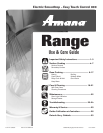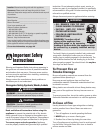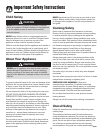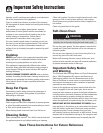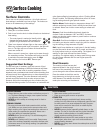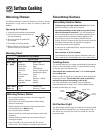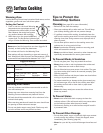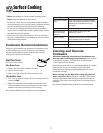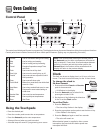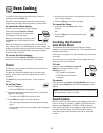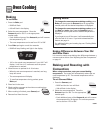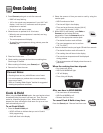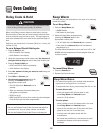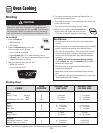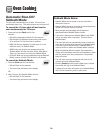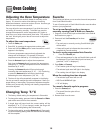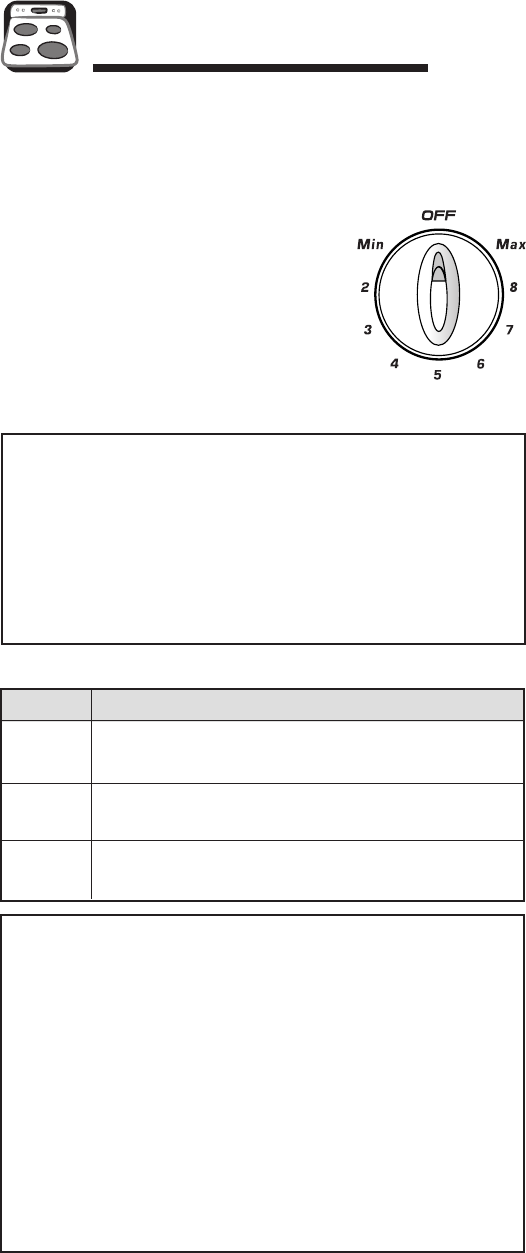
6
Surface Cooking
Tips to Protect the
Smoothtop Surface
Cleaning (see page 20 for more information)
• Before first use, clean the cooktop.
• Clean your cooktop daily or after each use. This will keep
your cooktop looking good and can prevent damage.
• If a spillover occurs while cooking, immediately clean the
spill from the cooking area while it is hot to prevent a tough
cleaning chore later. Using extreme care, wipe spill with a
clean dry towel.
• Do not allow spills to remain on the cooking area or the
cooktop trim for a long period of time.
• Never use abrasive cleansing powders or scouring pads
which will scratch the cooktop.
• Never use chlorine bleach, ammonia or other cleansers not
specifically recommended for use on glass-ceramic.
To Prevent Marks & Scratches
• Do not use glass pans. They may scratch the surface.
• Never place a trivet or wok ring between the surface and
pan. These items can mark or etch the top.
• Do not slide aluminum pans across a hot surface. The pans
may leave marks which need to be removed promptly. (See
Cleaning, page 20.)
• Make sure the surface and the pan bottom are clean before
turning on to prevent scratches.
• To prevent scratching or damage to the glass-ceramic top,
do not leave sugar, salt or fats on the cooking area. Wipe
the cooktop surface with a clean cloth or paper towel
before using.
• Never slide heavy metal pans across the surface since
these may scratch.
To Prevent Stains
• Never use a soiled dish cloth or sponge to clean the
cooktop surface. A film will remain which may cause stains
on the cooking surface after the area is heated.
• Continuously cooking on a soiled surface may/will result in
a permanent stain.
To Prevent Other Damage
• Do not allow plastic, sugar or foods with high sugar content
to melt onto the hot cooktop. Should this happen, clean
immediately. (See Cleaning, page 20.)
• Never let a pan boil dry as this will damage the surface and
pan.
Warming Zone Notes
• Use only cookware and dishes recommended as safe for
oven and cooktop use.
• Always use oven mitts when removing food from the
Warming Zone as cookware and plates will be hot.
• All foods should be covered with a lid or aluminum foil to
maintain food quality.
• When warming pastries and breads the cover should have
an opening to allow moisture to escape.
• Do not use plastic wrap to cover foods. Plastic may melt
on to the surface and be very difficult to clean.
Suggested Settings
Setting Type of food
Min - 2 Breads/Pastries Gravies Eggs
Casseroles
2 - 5 Dinner Plate with Food Sauces Stews
Soups (Cream) Vegetables Meats
5 - Max Hot Beverages Liquid Soups
Fried Foods
Warming Zone
Use the Warming Zone to keep hot cooked foods warm, such as
vegetables, gravies and oven-safe dinner plates.
Setting the Control:
1. Push in and turn the knob. Warming
temperatures are approximate and are
indicated on the control as Min, 2-8 and
Max. However, the control can be set to
any position between Min and Max.
2. When done, turn the control to OFF and
remove food. The Hot Surface indicator light
will go off when the Warming Zone surface has cooled.
Notes:
• Never warm food for longer than one hour (eggs for 30
minutes), as food quality may deteriorate.
• Do not heat cold food on the Warming Zone.
• Heat settings will vary depending on type and amount of
food. Always hold food at proper food temperatures. USDA
recommends food temperatures between 140°-170° F.



